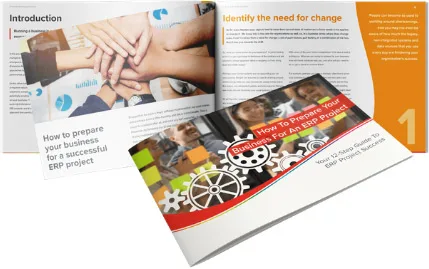Efficient processes drive business success, enabling companies to streamline operations, cut costs, and improve productivity. To achieve process efficiency, businesses need a combination of the right strategies, tools, and practices. In this guide, we will explore how ERP software solutions with industry-specific tools can enhance your operational efficiency.
Creating a Business Case for ERP
How to Create a Business Case for ERP that will be Approved!
We’ll hazard a guess that if you’re reading this you don’t presume that upper management will automatically see the benefit when it comes to embarking on an enterprise resource planning (ERP) implementation project. We will assume that you have probably already identified the need to create some sort of business case to justify your investment. You may have even read our 12 Step Guide to ERP Project Success and have a fairly good idea now of what is involved in undertaking an ERP project overall.
But how do you guarantee that your business case will present an indisputable argument for your new ERP solution and garner full support for your project?
The ‘secret sauce’ most people don’t get right that will make ALL the difference
Many business cases focus on the potential benefits of new ERP software while ignoring, or not exploring in enough depth, the problems their business is facing and the associated costs. This is where they fall over: not outlining the true cost of their problems in enough detail makes it difficult to accurately demonstrate the return on investment (ROI) and hence justify the appropriate level of spend.
‘What is the cost of doing nothing?’ is a powerful question that many ERP project owners simply don’t take the time to ask, or don’t because they consider those costs to already be sunk as part of day to day operations.
The cost of doing nothing is the cost of your problem if you don’t address it. Many people don’t take their business cases to this level. They simply explain what the problem is…perhaps even the root cause (if they manage to get to the true root cause), but they haven’t calculated the actual costs of the problem.
It could be this missing component that gets your business case approved!
The cost of doing nothing can be both tangible (monetary) and intangible (personal impact, reputation, future opportunities, etc).
Let’s explore some of the potential sources of your tangible and intangible costs and how to calculate them.
How to Identify Tangible Costs in Your Business
Once you know where the business needs to change and improve, and where your systems and processes are holding you back, you need to quantify what the monetary cost of this problem is. If you did nothing, if you left things as they are, what will this cost you in the long run? This can then be translated into costs per year and extrapolated over a longer period of time to help you work out a return on investment if you did proceed with change.
Some examples of calculating the costs of a problem:
1. Job operations are not scheduled in a way that ensures the machines are optimised to be used most effectively
This can lead to expensive machinery sitting idly and not doing anything, while other machines are worked beyond their capacity and struggling to meet demand.
Let’s say you have two jobs that require the same machine, however the machine has the capacity for processing a single job at a time. You want to make sure that when the machine finishes the required operation for the first job the second job is lined up to start immediately. The first job moves onto the next process without delay. Often though, if machines are scheduled manually they can be left idle or jobs waiting for operations that could be underway.
Another way machine efficiency is achieved is through batching. Could two jobs be batched to process at the same time on the same machine, rather than one after the other? What is the cost to your business of not having the necessary visibility and controls to make these kinds of decisions?
2. Carrying too much inventory
If you don’t have good inventory control, you don’t have faith in your stock holding or your ability to fulfil orders. This can result in over-ordering inventory materials to meet your desired service level, tying up valuable capital and requiring more warehouse space, and can potentially lead to wastage.
3. Poor control over your running costs
Whatever industry you are in, operational efficiency is critical to running a sustainable business delivering quality outcomes – and hitting your financial goals.
In Aged Care for example, there is a huge transactional cost in managing residents, and many man hours required in performing the day-to-day tasks associated with running their facilities.
The overhead of transaction processing and data maintenance involved in tasks such as making monthly claims, reporting and managing occupancy can add up to enormous operational costs, for little return. Saving time on non-value adding activities through automation allows you to focus on revenue generating activities.
4. Not claiming everything you are entitled to
This is a common example of an avoidable cost for our customers who manage large and complex contracts and projects. Are you claiming for everything you are entitled to, when you are entitled to it, from the customer as per your contract? Are you billing for variations accurately, and how effective are you at billing these on time and ensuring they are not missed?
5. Lack of communication between areas of the business
A costly example of a lack of communication or lack of visibility within a business is the critical relationships that exist between contract management, project execution and the shop floor. Manufacturers who manage to contract usually operate most efficiently when the materials they’re sourcing and the subcontract services they’re procuring are being done ‘on time’ and not before or after. A disconnect between these functions of the business can result in lost time and delivery delays. If items aren’t delivered to the right spec and on time, it potentially leaves you open to financial penalties.
How to Identify Intangible Costs in Your Business
So, we have worked through the tangible costs but what does this mean to your stakeholders? A great way to structure a business case can be to present your root cause of the problems and the tangible costs of doing nothing as explored above, and then dig into what the change will mean to the stakeholders. How is their life impacted currently, and what will it look like if these problems are addressed?
Your employees, executive, customers and perhaps even partners and suppliers will be feeling the impacts of these costs. People make business decisions based on emotions as well as numbers. Find out what is driving the need for change emotionally.
It can be useful to ask your key stakeholders about their own pain points. What does the customer experience look like now and where are the areas for improvement? Where are employees feeling the pinch? Are there any key performance indicators (KPIs) the executives are measuring that are falling below target? Are there any real or perceived risks to the business in terms of reputation? What are the opportunities we are missing because we are too busy managing the day-to-day operations of our business?
C-suite executives (who are often the ones reviewing your business case) are also often concerned about an initiative failing on their watch. An ERP project is a substantial investment and they need to have confidence in the proposed solution. Confidence comes with numbers backed by facts, and a compelling emotional argument.
How do you Calculate the Tangible Costs of Your Business Problems?
The first step is to do a deep dive into your business problems through using root cause analysis tools. You need to make sure you get to the underlying cause. Often, people see the symptoms of the problem and try to address these. This only temporarily masks the real cause of the problems, leaving them still under the surface, waiting to manifest again.
The next step is to calculate the cost of these problems. Machine idle time, excess stock, wastage, labour costs, rent – the list goes on, and it can add up!
Next, determine your return on investment by calculating how much you will save by removing the cost of these problems over the course of a one, three, five and ten year period, minus the cost of your investment in the ERP solution.
This information, together with the intangible costs and feedback received from your key stakeholders will form this basis for your indisputable business case. These facts will give your business case depth, evidence-based calculations and clarity. If you get this right, approval of your business case will be a ‘no brainer’.
How Can We Help?
If you need help with identifying the root cause of your problems and how to calculate the business cost of these problems to create a compelling business case for your ERP project, we can help you get started with our free Break Through the Bottleneck Consult.
One of our ERP solution specialists will use our specially designed diagnostic tools to help you uncover your core issues and what these may be costing your business (both monetary and lost opportunities). PLUS we will document this for you, so you can feed the information into your request for proposal (RFP) and business case documents.
It starts with a 15 minute call to set up the meeting and for us to learn more about your business so that you get the most value from this session. To get started, simply book a time in our calendar.
Related Articles
Epicor Kinetic’s Answer to SQL Bottlenecks
Epicor Kinetic’s SQL to BAQ Generator simplifies data analytics and streamlines workflows by converting SQL queries into intuitive, easy-to-use BAQs.
Why Choose Epicor Kinetic?
This article explores 8 key reasons why Epicor Kinetic ERP stands out as the top choice for product-centric businesses. With industry-specific functionality, a cloud-native architecture, and data-driven insights, Epicor Kinetic empowers manufacturers, distributors, and retailers to optimise operations and drive growth.
ERP Features vs. ERP Functions
This article explores the critical distinction between ERP features and functions, and how understanding this difference has empowered businesses like Milne Agrigroup, Steel Blue, KLINGER, and Hypex Electronics to maximise the value of their ERP systems, leading to streamlined operations, improved decision-making, and driving growth.
Epicor Customer Awards 2023
Bruce Rock Engineering shined at the recent Epicor Insights ANZ Conference 2024 taking out the Manufacturing Champion Award 2023. BRE’s strategic decision to implement Epicor Kinetic two years ago has transformed their operations, propelling them to greater efficiency and competitiveness.
How ERP Optimises ETO Processes
ERP migration is a transformative process that can propel businesses toward greater efficiency and competitiveness. By adopting a strategic approach and leveraging the expertise of an ERP implementation partner, companies can navigate the complexities of migration, ensuring a smooth transition from legacy systems to modern ERP solutions.


